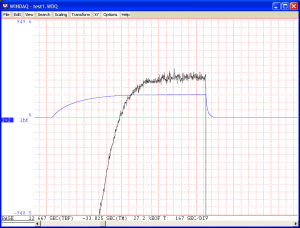A customer contacted our support group the other day to complain about noise on his load cell signal and asking for the best way to remove it. We’ve seen this movie before and asked for a sample in the form of a recorded WinDaq data file so we could see how the measurement was configured and judge the severity of the noise for ourselves. The nearby graphic is a WinDaq screenshot of what was returned.
The blue and black waveforms are actually the same signal, but the black is shown at 12 times magnification. If you focus on the black waveform it’s hard not agree with our customer, that the signal is indeed noisy. However, noise (or the lack thereof) is often a subjective measure, and we wanted to provide this customer with a quantitative response.
Fortunately, all the tools we needed to do this are built into WinDaq Playback software. The first item required is a measure of the actual peak-to-peak noise, which is easily obtained using WinDaq’s Statistics function. We obtained statistics for the static and highest portion of the waveform where it plateaus, a total of 118 points. WinDaq Stats returns a number of values, but for our purpose we needed only the minimum and maximum values of the 118 because the difference between them is a good proxy for worst-case noise. The values were 220.23 and 217.45 (pounds of force) for the maximum and minimum values respectively to yield a difference of 2.78. However, a noise factor of 2.78 is meaningless unless it’s put into perspective, and the best way to do that is to express it as a percentage of the full scale range of the measurement. After all, what’s worse, a 2.78 noise factor when the full scale range is 10 pounds of force, or when it’s 100? Fortunately again, WinDaq Playback software allows us to easily determine the dynamic range of the measurement, a value of 949.6. Now we had all we needed to respond convincingly and quantitatively that the amount of noise present on the signal is a very small 0.29% of the full scale range. Keep in mind also that this is an absolute worst case measure, with the majority of the noise well below this threshold.
All things considered, ambient and conducted electrical noise, signal lead exposure, indecision of the A-D converter, etc. this customer is doing very well with his measurement. However, we probably could have argued that all day with him on a subjective basis without resolution. Determining the actual noise factor and expressing that as a percentage of the full scale range lends perspective that is much more convincing.


 View Cart
View Cart sales@dataq.com
sales@dataq.com 330-668-1444
330-668-1444